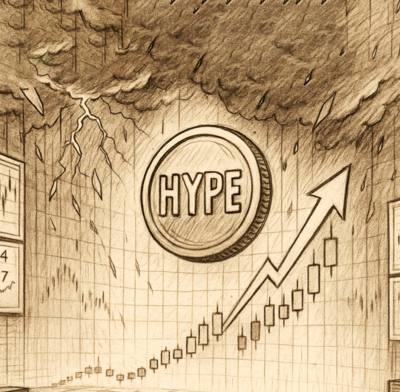HYPE climbed to a new all-time high of $59 in September, a 146% increase since January 1, before retreating to around $48. Arthur Hayes, founder of BitMEX, made headlines after disclosing he sold his HYPE allocation just weeks after publicly projecting a potential 126x valuation by 2028, pointing to upcoming token unlocks as a concern. The sale netted Hayes roughly $800,000 in profit and reignited debate about the project’s sustainability.
HYPE’s Record Run Faces Unlock Headwinds as Leverage Builds

Revenue growth meets supply headwinds
Hyperliquid, the platform behind HYPE, has quickly established itself as the leading on-chain trading venue. Trading volumes reached $2.1tn year-to-date across 696,000 users, underscoring the platform’s rapid growth. In August alone, the platform generated $122mn in revenue, while September month-to-date sits at $66mn. Token Terminal data shows derivatives activity accounts for 91% of its revenue, compared with 8% from spot and 1% from HyperEVM.

(Source: Token Terminal)
A key feature of HYPE’s tokenomics is the Assistance Fund, introduced in January 2025. The mechanism channels 97% of platform revenue into automated buybacks of HYPE, effectively removing tokens from circulation. The fund currently holds 31.3mn tokens valued at $1.5bn, ranking among the most aggressive buyback programs in the sector.
Yet supply dynamics remain challenging. Beginning 29 Nov, roughly 9.92mn tokens will unlock each month for the next 24 months, equal to about $500mn in monthly supply at current prices. With buybacks absorbing only a quarter of that flow, the market faces a potential $370mn monthly net supply overhang.
Derivatives positioning signals diverging views
Despite HYPE’s recent pullback, derivatives activity remains elevated. Funding rates are currently at 21%, highlighting the extent of leveraged long positioning in the market, while open interest has climbed to a record $693mn.

(Source: Coinmetrics)
This positioning could reflect two competing dynamics. On one hand, traders may be pricing in continued exchange growth, wagering that sustained revenue-driven buybacks will outpace upcoming token unlocks. On the other hand, the build-up of highly leveraged longs raises the risk of a destabilizing unwind, particularly if spot selling from unlocks accelerates into year-end.
The next month will be a critical test: whether Hyperliquid’s revenue engine can absorb the incoming supply, or whether elevated leverage amplifies downside pressure if expectations fall short.






